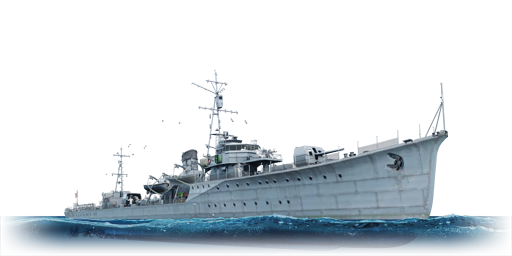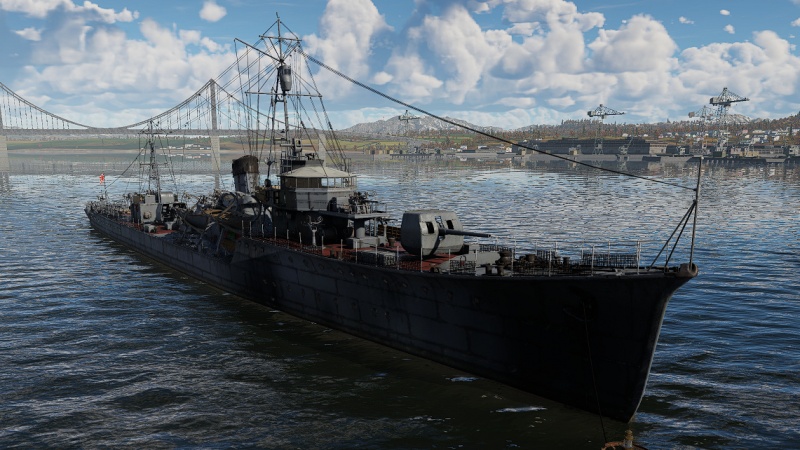Chidori
Contents
Description
The Chidori-class, Chidori (千鳥, namesake: Plover) was a 600-ton Chidori-class vessel that was designed to avoid the restrictions of the London Navy Treaty on destroyer tonnage. It was classified as a torpedo boat instead of a destroyer, even though it had half the firepower of the Fubuki-class destroyer. However, the Chidori class had problems with stability and weight due to its excessive armament. The 3rd ship of the class, Tomozuru, capsized during a naval exercise and raised doubts about the quality of Japanese ships. The Chidori class was modified by reducing and changing its weapons (from 12.7 cm to 12 cm guns and removing one torpedo mount) and adding bulges. The remaining 16 ships out of 20 planned were canceled and the funds were redirected to a new Ōtori-class torpedo boat, which had better balance.
The Chidori was introduced in Update "Raining Fire". Designed as a lighter vessel carrying destroyer armament to evade the Naval Treaty, in War Thunder as her final 1944 refit she hasn't escaped, and instead faces the destroyers she was designed to mimic with weaker firepower. Only offering a single dual 533 mm torpedo mount and three 12 cm cannons, she plays like a weaker and more vulnerable Mutsuki-class, but at the end of the tree resulting in a lengthier grind for the same destroyer introductory gameplay. One of the redeeming factors Chidori has as a 1944 refit is her array of 25 mm anti-air which is far superior to her opponents and will leave pilots surprised to face heavy AA resistance at this tier.
General info
Survivability and armour
Talk about the vehicle's armour. Note the most well-defended and most vulnerable zones, e.g. the ammo magazine. Evaluate the composition of components and assemblies responsible for movement and manoeuvrability. Evaluate the survivability of the primary and secondary armaments separately. Don't forget to mention the size of the crew, which plays an important role in fleet mechanics. Save tips on preserving survivability for the "Usage in battles" section. If necessary, use a graphical template to show the most well-protected or most vulnerable points in the armour.
Mobility
Write about the ship's mobility. Evaluate its power and manoeuvrability, rudder rerouting speed, stopping speed at full tilt, with its maximum forward and reverse speed.
| Mobility Characteristics | |||||
|---|---|---|---|---|---|
| Game Mode | Upgrade Status | Maximum Speed (km/h) | Turn Time (s) | Turn Radius (m) | |
| Forward | Reverse | ||||
| AB | Stock | 53 | 18 | ~90.7 | ~148.36 |
| Upgraded | ___ | ___ | |||
| RB/SB | |||||
| Upgraded | ___ | ___ | |||
Modifications and economy
Armament
Primary armament
Provide information about the characteristics of the primary armament. Evaluate their efficacy in battle based on their reload speed, ballistics and the capacity of their shells. Add a link to the main article about the weapon: {{main|Weapon name (calibre)}}. Broadly describe the ammunition available for the primary armament, and provide recommendations on how to use it and which ammunition to choose.
| Penetration statistics | |||||||
|---|---|---|---|---|---|---|---|
| Ammunition | Type of warhead |
Penetration @ 0° Angle of Attack (mm) | |||||
| 1,000 m | 2,500 m | 5,000 m | 7,500 m | 10,000 m | 15,000 m | ||
| 120 mm Type 1 HE | HE | 24 | 24 | 24 | 24 | 24 | 24 |
| 120 mm Type 1 SAP | SAP | 114 | 89 | 59 | 40 | 30 | 26 |
| 120 mm Type 0 HE | HE-TF | 24 | 24 | 24 | 24 | 24 | 24 |
| Shell details | ||||||||||||
|---|---|---|---|---|---|---|---|---|---|---|---|---|
| Ammunition | Type of warhead |
Velocity (m/s) |
Projectile mass (kg) |
Fuse delay (s) |
Fuse sensitivity (mm) |
Explosive mass (TNT equivalent) (kg) |
Ricochet | |||||
| 0% | 50% | 100% | ||||||||||
| 120 mm Type 1 HE | HE | 850 | 20.33 | 0 | 0.1 | 1.95 | 79° | 80° | 81° | |||
| 120 mm Type 1 SAP | SAP | 850 | 20.4 | 0.015 | 5 | 1.87 | 47° | 60° | 65° | |||
| 120 mm Type 0 HE | HE-TF | 850 | 20.33 | 0 | 0.1 | 1.95 | 79° | 80° | 81° | |||
Secondary armament
Some ships are fitted with weapons of various calibres. Secondary armaments are defined as weapons chosen with the control Select secondary weapon. Evaluate the secondary armaments and give advice on how to use them. Describe the ammunition available for the secondary armament. Provide recommendations on how to use them and which ammunition to choose. Remember that any anti-air armament, even heavy calibre weapons, belong in the next section. If there is no secondary armament, remove this section.
Additional armament
Describe the available additional armaments of the ship: depth charges, mines, torpedoes. Talk about their positions, available ammunition and launch features such as dead zones of torpedoes. If there is no additional armament, remove this section.
Usage in battles
The Chidori in playstyle is closer to a BR (AB) anti-air destroyer than to a motor gun boat. It features just half the main guns and torpedoes of the IJN Mutsuki (at BR ), but a much, much more potent secondary, 25 mm battery. Unlike other nations top-tier coastal vessels, it does not have access to the HE-VT shells which puts it in a significant disadvantage comparing to its peers. However, it's still one of the best anti-air options in this BR range for the Japanese fleet, leaving it only to the JDS Ayanami (DD-103) for providing a more efficient anti-air cover.
Pros and cons
Pros:
- Main and secondary guns are able to quickly destroy enemy boats
- Numerous 25 mm guns all throughout the ship offer excellent anti-air cover
- Relatively manoeuvrable
Cons:
- Large size, no armour, below-average crew count contribute to a low survivability
- Low maximum speed and unable to sail through the shallow waters
- Very slow turret rotation
- Primary cannons have blind spot on back of the ship
- Lacklustre primary guns comparing to any fully-fledged destroyer in the BR range cause the ship to struggle against frigates, sub-chasers or any bluewater ships
- No access to the HE-VT shells
- No access to the shell chase camera for the primary armament
History
Design
The Chidori (Japanese for plover bird) was the first boat of the Chidori-class torpedo boats (Torpedo boat here has a different meaning than a small motor boat, closer to the meaning of destroyer). She was laid down in 1931 at the Maizuru Naval Construction Department.
Service
In December 1936, the Torpedo flotilla 21 was formed with the four boats of the same class and advanced toward China, engaged in landing support and blockade operations. After the start of the Pacific War, they supported the strategy of the Japanese Southern expansion. After that, the flotilla was disbanded and Chidori was engaged in convoy escort. Although she was active until the end of the war, the Chidori was sunk by a torpedo of the US submarine "Tilefish" off the coast of Omaezaki in Southern Japan on December 22, 1944.
Media
- Skins
See also
Links to articles on the War Thunder Wiki that you think will be useful for the reader, for example:
- reference to the series of the ship;
- links to approximate analogues of other nations and research trees.
External links
Paste links to sources and external resources, such as:
- topic on the official game forum;
- other literature.
| Maizuru Naval Arsenal (舞鶴海軍工廠) | |
|---|---|
| Torpedo Boats (TB) | |
| Chidori-class | Chidori |
| Destroyers (DD) | |
| Yugumo-class | IJN Yugumo · IJN Hayanami |
| Shimakaze-class | IJN Shimakaze |
| Akizuki-class | IJN Akizuki · IJN Hatsuzuki |
| Japan boats | |
|---|---|
| Motor torpedo boats | Type T-1 · Type T-14 · Type T-14 (mod. 1) · Type T-38 · Type T-51a · Type T-51b |
| PT-802 · PT-808 · PT-15 | |
| Motor gun boats | Ha-Go (mod. 1) · Type 4 (mod. 2) · Type 4 (Mod 4) |
| Asagao (YTE-01) · PG 02 | |
| Armoured gun boats | Soukou-Tei · Soukou-Tei No.4 |
| Gunboats | Chidori |





